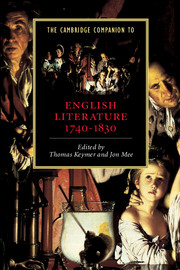Book contents
- Frontmatter
- Part I Contexts and modes
- Part II Writers, circles, traditions
- 8 Richardson, Henry Fielding, and Sarah Fielding
- 9 Johnson, Boswell, and their circle
- 10 Sterne and Romantic autobiography
- 11 Blake and the poetics of enthusiasm
- 12 ‘Unsex’d females’
- 13 The Lake School
- 14 Jane Austen and the invention of the serious modern novel
- 15 Keats, Shelley, Byron, and the Hunt circle
- 16 John Clare and the traditions of labouring-class verse
- Index
- Series list
11 - Blake and the poetics of enthusiasm
from Part II - Writers, circles, traditions
Published online by Cambridge University Press: 28 May 2006
- Frontmatter
- Part I Contexts and modes
- Part II Writers, circles, traditions
- 8 Richardson, Henry Fielding, and Sarah Fielding
- 9 Johnson, Boswell, and their circle
- 10 Sterne and Romantic autobiography
- 11 Blake and the poetics of enthusiasm
- 12 ‘Unsex’d females’
- 13 The Lake School
- 14 Jane Austen and the invention of the serious modern novel
- 15 Keats, Shelley, Byron, and the Hunt circle
- 16 John Clare and the traditions of labouring-class verse
- Index
- Series list
Summary
Academic accounts of the differences between eighteenth-century and Romantic poetry are often over-stated, sometimes accepting on trust self-interested narratives of the renaissance of a pure poetry of imagination and feeling such as Wordsworth's 'Essay, Supplementary to the Preface' (1815). The rebirth of 'pure poetry' was being declared as early as Joseph Warton's Essay on the Writings and Genius of Pope (1756), and even some decades before. Warton wrote against satire and what he saw as the versified morality of the Scriblerians, yet he could still find in Pope's Eloisa to Abelard (1717) at least signs of the raptures of the true poet: 'Poetry, after all, cannot well subsist, at least is never so striking, without a tincture of enthusiasm' (i: 320). Shaun Irlam's recent study of mid-century poetry describes the emergence of a 'poetics of enthusiasm'. Joseph Addison, John Dennis, and Shaftesbury are identified as the critical progenitors and James Thomson and Edward Young the major poets of this cultural transformation. Others that Irlam would include in his line of enthusiasm include Mark Akenside, William Collins, Thomas Gray, Christopher Smart, and Joseph and Thomas Warton.
- Type
- Chapter
- Information
- The Cambridge Companion to English Literature, 1740–1830 , pp. 194 - 210Publisher: Cambridge University PressPrint publication year: 2004
- 2
- Cited by



